The Foundation of Freedom is the Courage of Ordinary People History 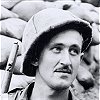 On Line On Line |
.303 Lee Enfield Rifle and Manual The bolt action, Caliber .303 in. Magazine Lee-Enfield, MLE, held two columns of 5 cartridges each. A skilled soldier could fire the 8.8 lb rifle's deadly 174 grain bullet at from 20 to 30 aimed rounds per minute, making British Commonwealth infantry as effective as any in the Korean War.
Rifle Manual: Lee Enfield Rifles No.1 Mk III; No.3 Mk I; No.4 Mk I; No. 5 Mk I TM9-2200 (html): Technical Manual for WWII Small Arms
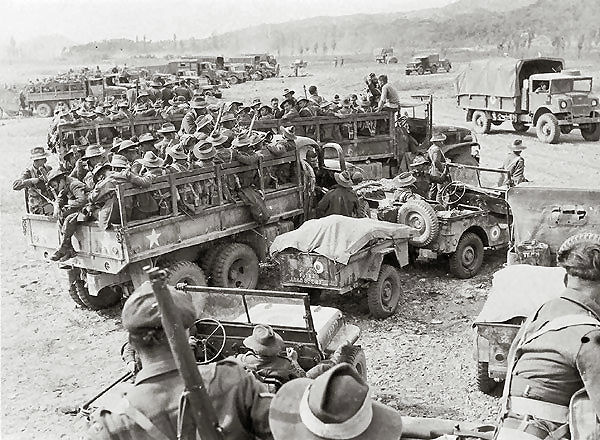
(British Commonwealth Occupation Forces Japan photo.)
| 3rd Battalion, Royal Australian Regiment, armed with Number 4 Mark I SMLE rifles, distinguished itself in Korea in a number of engagements. In its first fight the Aussies, using mainly only Enfield rifles and 18 in. bayonets, routed a North Korean regiment. In three years of some of the worst fighting of the Korean War, 3RAR was never forced from a position.
| The .303 caliber Lee-Enfield rifle, November 1895,usually called the Magazine Lee-Enfield, or MLE. The next year a shorter version was introduced as the Lee-Enfield Cavalry Carbine Mk I, or LEC, with a 21.2-inch barrel as opposed to the 30.2-inch "long" version. After modifications, in 1899 they became the Mk I. Some of the MLEs (and MLMs) were modified to load from chargers, "Charger Loading Lee-Enfields", or CLLEs. 
Rifle, Short, Magazine Lee Enfield (SMLE) Mark 1 The SMLE, January 1904, is a shorter and lighter version of the MLE. Barrel length was halfway 25.2 inches, halfway between the original long rifle and the carbine. There was concern at the time that the shorter barrel would not be accurate, with greater recoil, and too short a sighting radius. The most noticeable characteristic of the SMLE was its blunt nose, with only the bayonet boss protruding a small fraction of an inch beyond the nosecap. The SMLE included charger loading, borrowed from the Mauser rifle. 
Rifle, Short, Magazine Lee Enfield Mark 3 -- 1907, different sights The SMLE Mk III, 26 January 1907, featured a simplified rear sight arrangement and a fixed charger guide, and was chambered to fire the Mk VII High Velocity spitzer .303. During WWI, many changes were made to simplify manufacture and help meet production requirements, resulting in the SMLE Mk III* (redesignated Rifle No.1 Mk III* in 1926) saw extensive service throughout the Second World War as well, especially in the North African, Italian, Pacific and Burmese theatres in the hands of British and Commonwealth forces. The SMLE was manufactured in Australia and India, and the old faithful 4 mk1 .303 was standard-issue for the Royal Australian Regiment in the Korean War, helping to make them at least as effective as any infantry in that miserable war. |
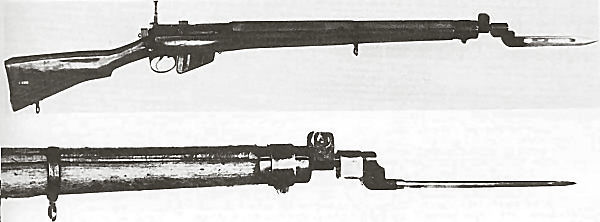
Rifle, Short, Number 4 Mark 1, Short, Magazine Lee Enfield - 1941 Top shown mounting Bayonet Number 9, bottom blow-up mounts "Pig-Sticker" bayonet.
Interesting to some American Korean War veterans, the Enfield wasn't issued a flash protector. Quoting one of my Aussie Mates, Vince Gilligan (note the cone suppressor on his Bren in this link):
The cone type flash eliminators were standard on the Bren Gun and the Jungle .303 Carbine but I was a Infantry instructor and never came across one for the old faithful 4 mk1 .303. Another Aussie mate, Keith Hasler adds:
"Hi Bert ... I agree with Vince that our Lee Enfield Rifles had no flash suppressors, but our trusty Bren Gun had a cone shaped 'flash eliminator.' The remaining ammunition used was 9mil in the Owen sub machine gun (with no suppressors). Our Vickers belt fed and water cooled machine gun (also a .303 user) and equiped with a form of cone shaped suppressor, was used by specialist gunners in their own unit as opposed to the former three weapons used by the infantry troops in section, platoon and company sized operations.... Flash suppressors reduce the flash by rapidly cooling the gases as they leave the barrel, reducing the gas density and temperature and correspondingly the brightness of the flash. Obviously this is entirely to protect night vision of the shooter, not try to hide him from the shootee. | 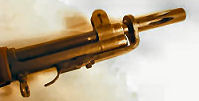
M1 QD Flash Hider

Cone suppressor

T-37 prong flash suppressor. |
|
| - | Mark 1 | Mark 3 | No. 4 Mark 1 | | - | Barley Corn foresight
Tangent Leaf Rear | Blade foresight
Tangent leaf Rear | Blade foresight
Vertical leaf Rear | | Operation | Bolt Action | | Caliber | .303 in, Rimmed cartridge, 2.15in case length | | Muzzle velocity | 2060 fps | 2440 fps | 2440 fps | | Ammunition | Mark 6 ball, 215 grain bullet, 33 gr charge
Mark 7 ball, 174 grain bullet, 36.5 gr charge | | Capacity | detachable box magazine, holding 10 rounds in two columns
Normally loaded from stripper clips | | Weight | 8.12 lbs, unloaded | 8.62 lbs, unloaded | 8.8 lbs, unloaded | | Overall length | 44.57 in overall, 25.2 in barrel | | Rate of fire | 20 aimed rounds per minute | |
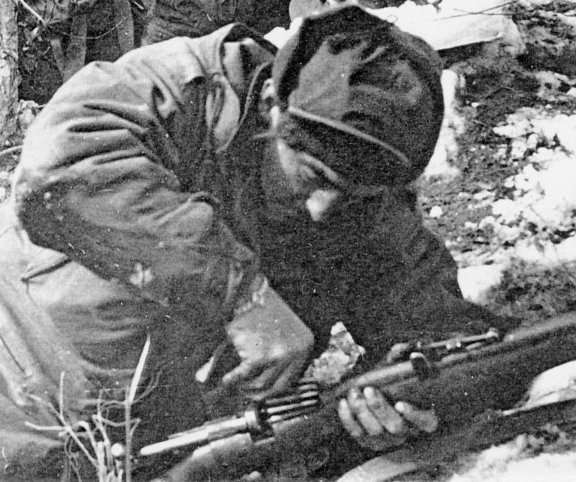
Corporal Donald Breyard Davie gives covering fire for "B" Company, 3RAR, during their advance on a spur near Hill 614.
| 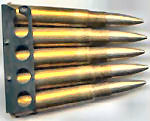 Corporal Davie had loaded his stripper clip the usual over-and-under method which alternates the rims of succeeding cartridges in front of then in back of, the rim of the previous cartridges. That's the way the clip on the left is loaded. In another method, the rim of each cartridge overlaps the rim of the previous cartridge. | The M1 Garand was the weapon of choice for US infantry. The M2 Carbine, half the weight and with a less powerful cartridge, was the weapon of choice for support troops, and others not primarily involved in infantry combat. It was designed to meet combat needs less demanding than the M1 Rifle, but more than can be met by the M1911A1 pistol. It was more convenient to use than the M1, and less intrusive to their other duties, while still much more effective than hand guns. When the Short Magazine Lee-Enfield was first introduced into British service, it met with a storm of criticism -- though little from the troops whom it served well during two World Wars, Korea, and beyond. British Commonwealth forces used the Lee Enfield Mark 4 as their main rifle. Although bolt action, its locking mechanism made it the fastest bolt action rifle in the world. Its long service also permitted its design to be optimized over time to make it very rugged and reliable. The trained soldier could fire 30 aimed rounds at a target 200 meters in one minute (known as "the mad minute"). | 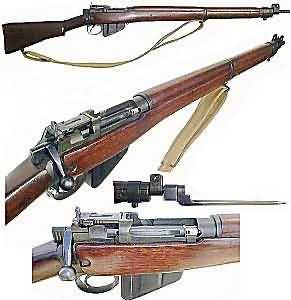
| 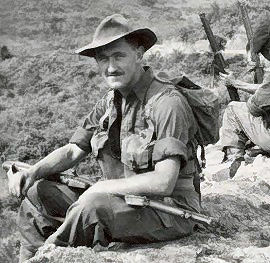
Ron Cashman, 3RAR | As one vet, Vince Gilligan, 3rd Battalion Royal Australian Army said: "... on the Lee Enfield .303 rifle our mob(Australians) used in Korea. The brits used a later version with the pig sticker bayonet. We had the 18in. bayonet (blued). One of the rifles I had was made in 1917-1918. It was a very effective weapon. At least if you hit something, it stayed Hit.' And after all, that's the idea. - The bluing process creates a protective layer of treated metal on the surface of the steel, by immersing the metal in a solution of salts that chemically alter the surface. The chemical reaction discolors the surface of the metal to a blue color, sometimes a vivid blue, sometimes more gray or black. |
| Clanton One browser, Shane, offered the following comments
These come for the Lee-Enfield No.4 MK1. I now own one and some of your information is a little off. Rear Sights are flip-up adjustable aperature micrometer sights, not vertical leaf Weight unloaded is Nine pounds even (I weighed it!) not 8.8 Barrel length is 25 1/4 inches, not 25 2 inches Case length is actually 2.222 inches (Chamber size) and not 2.15 And, as for the aimed shot capacity, it's actually more along the lines of 15 rounds per minute. Because of the way the Lee action is set up, rapid fire is very easy to do. As long as you've got some charger clips handy, you can manage 3in. groups on a rapid fire string. | Another browser responded
I am afraid I must disagree with Shane's opinion on Lee Enfield rate of fire. In British military rifle qualification with the SMLE the minimum passing score was 15 hits on a siluette target at 200 yards in 1 minute. This was required of any cook or clerk. Combat soldiers averaged 20 to 30 hits in 1 minute. The all time aimed fire record with a bolt action rifle was by Sgt. Snoxall of the British army, 38 hits on a 12in. bull at 300 yards in 1 minute.
Causes of the Korean Tragedy ... Failure of Leadership, Intelligence and Preparation
The Foundations of Freedom are the Courage of Ordinary People and Quality of our Arms
| |

